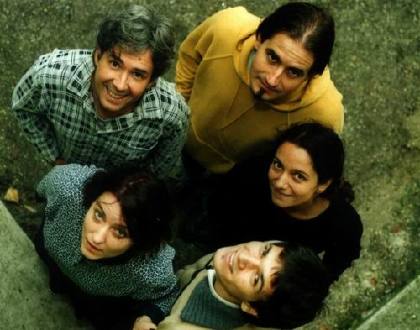Kiss Erzsi Music was formed in 1996 by Erzsi Kiss (vocals), Csaba Hajnoczy (guitar, sampler), and Gabi Kenderesi (vocals, violine), all the members have an experience of more than a decade in singing and playing.
Some of Kiss Erzsi Music's songs show influence of the Balkans, other ones of African or Turkish music, the Blues or the Latin world, but all of them are adopted to the playful, highly expressive and original presentation of the band.
The band's moniker is derived from their lead singer, Erzsi Kiss, translating as Erzsi Kiss Music. It's a name which has a humble simplicity and yet is audacious in that it seems to be aiming to define a new style of music (even if one that will be played by them) as much as the formal entity this particular grouping of musicians constitutes. And to a large degree they are successful in this, marking out musical territory which is quite distinctly theirs. As well as labelling this Erzsi Kiss Music, they also describe it as a kind of virtual world music in its use of global influences to create a sound which is ethnic, but doesn't have its roots in any one country.
The hallmark of the band's sound is the extraordinary voice of Erzsi Kiss, with strong support from Gabi Kenderesi (lead singer of Kampec Dolores) or overdubbing from herself, with guitarist Csaba Hajnóczy occassionally chipping in. Working with tightly weaved and multi-layered vocal arrangements, the band evokes tribal chants, folk melodies, religious music and meaningless playground ditties (amongst other things) using a wide selection of squeals, yelps and other assorted vocal contortions along with more conventional ethnic and Western harmonies.
Kiss was led to form the group in 1996 after a period of more than a decade in the theatre, in which time she studied African and Asian folk songs. The band provides a mature synthesis of diverse influences, and one that shows a deep intuitive musical understanding. But for all this the music is far from a po-faced academic exercise and the music exudes a sense of seriously good childhood fun, emphasised in the child-like drawings for album's artwork.
With so much attention on the vocalists, it is not surprising that out of the albums' 16 tracks, five of them are a cappella. On the remainder of the numbers, Hajnóczy and drummer Tamás provide a laid-back accompaniment. In contradiction to the computer capability of the CD (shove it in your pc and you get a pretty picture to look at while you tap your feet along to the music), the sound of the band is remarkably rooted in the analogue world.



